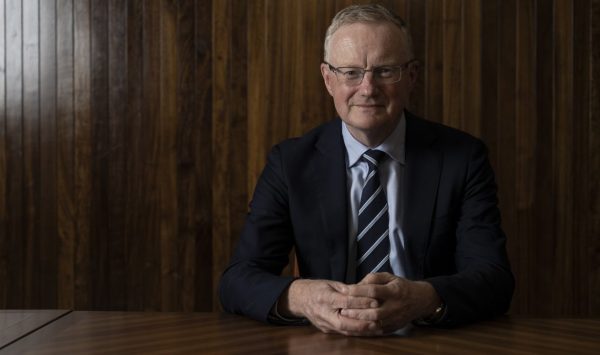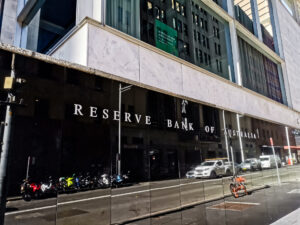
The decision by the Reserve Bank of Australia this week to increase official interest rates by half a percentage point surprised many. The bank is a notoriously conservative organisation. It usually likes to take things slowly. As it spent the last year suggesting it was unlikely to do anything drastic on interest rates until wages started to grow strongly, its decision to lift rates by half a point when real wages are falling was not very conservative. Things are changing fast.
While we talk a lot about interest rates in Australia, we don’t talk much about what they are supposed to do to the economy. Economists call the link between interest rates and inflation the monetary policy transmission mechanism, but in reality it is a long list of maybes.
Everyone knows that when we increase interest rates people with variable home loans have to spend more on their repayments and, in turn, they will spend less money on other things. But as only about a third of people have mortgages, and a lot of those have fixed-rate mortgages, most Australians are unaffected by this link in the transmission mechanism. Luckily for the Reserve Bank, another third of Australians own their homes outright and higher interest rates mean house prices will fall, which the RBA assumes will make them feel less well-off and consequently less likely to spend money. Then there are businesses that the banks assume will invest in less new equipment when interest rates are higher. Again, that’s a lot of maybes, although there is evidence that each of those effects will kick in a bit, eventually.
“Regardless of the objectives of the RBA, when young families have million-dollar mortgages and our wealthiest retirees have tens of millions in superannuation, small changes in interest rates have enormous consequences for the distribution of pain and profit in Australia.”
Precision aside, it’s a safe bet that when interest rates rise some people and some businesses will buy less stuff and, as a result, some firms will stop putting up their prices. The result will be lower inflation – unless something unexpected happens. Of course, it was unexpected things, not rampant consumer spending, that caused this latest surge in inflation.
For decades Australians, and the RBA, have been trained to focus on one form of price pressures known as demand-driven inflation. Surges in demand drive up prices – think prawns, hotel rooms and flights at Christmas time – but when unemployment is low, wages are high and businesses are doing lots of investing, all that spending drives up the price of everything. Companies use higher prices to ration the things they sell when they are in short supply. When lots of prices start to rise, the RBA hits the brakes by making us all spend more money on interest payments and less on the things we want to buy.
But Australia’s current outbreak of inflation isn’t caused by surging consumer demand or surging business investment; it’s being caused by worldwide increases in the price of energy and a wide range of consumer goods. Economists call this cost-push inflation and, importantly, hitting the Australian interest rate brakes will not do much to lower our inflation when there is a global freight train pushing it along.
Some commentators have criticised the RBA for not starting to increase interest rates earlier this year, arguing we should have tried to nip inflation in the bud. But while interest rate policy can be effective against demand-pull inflation, it is powerless against the form of cost-push inflation that is currently driving up the cost of living in Australia. While policy-makers love to “do something” in a crisis, the reality is Australia finds itself in a unique situation and the old scripts about economic management don’t fit comfortably with the new economic reality, or indeed with the new government’s thinking.
Luckily there is an impending review of the role of the RBA. While that will do nothing to help push down the price of oil or lettuce, hopefully it will help Australia to develop a more sophisticated approach in responding to problems as diverse as energy price shocks, chronically low wage growth and the cost of housing in this country. In the meantime, the question is what the RBA is likely to do next and what it should do in the years ahead.
In the short term it is almost inevitable that the RBA will keep increasing interest rates and, as a result, the mortgage repayments of a third of Australians will continue to rise, house prices will flatline or fall, and many businesses facing higher borrowing costs and customers with less money are likely to hit pause on their expansion plans.
None of this will stop the war in the Ukraine or speed up silicon chip production in China, but it will curb the enthusiasm for profitable price rises by the oligopolies that dominate the Australian economy. Which brings me back to the upcoming review. Energy and silicon chips aren’t the only things pushing up prices in Australia. The growing profit margins of Australian businesses are playing a major role as well. Ten years of low wage growth has, not surprisingly, caused 10 years of steady increases in the share of GDP that goes to profits.
While our media is full of stories about businesses that “have no choice” but to lift their prices, our national accounts are full of evidence that there has never been a better time to be an Australian capitalist. That’s not to say that some companies aren’t doing it tough, but it’s time Australia stopped pretending that because their local cafe owner is struggling to find staff, Harvey Norman or the Commonwealth Bank need our sympathy.
Much of our current debate about inflation revolves around the danger of a wage-price spiral, but with real wages falling faster than at any point on record, how could that be a risk?
Australia is in the grip of a profit-price spiral, where companies are using higher prices for some of their inputs as a cover story for large increases in their profit margins. Yes, grain prices have risen, but grain accounts for a trivial percentage of the retail price of a loaf of bread and wages account for a minority of costs for most Australian businesses.
One thing the upcoming inquiry into the RBA needs to consider is who is on the bank’s board. While it was once taken for granted that the Australian Council of Trade Unions would be represented, these days only business leaders and public servants get a voice. Given record low wage growth and the role of profits in driving inflation, it is clearly time for this to change. But while some genuine diversity of opinion is good for the governance of any organisation, the review of the RBA also needs to look further.
The Reserve Bank Act 1959 instructs the bank’s board to conduct monetary policy “to the greatest advantage of the people of Australia”. Specifically, it instructs them to pursue “the maintenance of full employment”. The act makes no specific mention of inflation. Despite this clear legislative obligation, for decades the bank has chosen to prioritise inflation management over the goal of full employment. To be clear, the RBA believes that if it controls inflation, unemployment will fix itself. It’s like someone who promised to cook dinner saying they thought cleaning the bathroom was a good start.
If the RBA doesn’t want to be responsible for delivering full employment, then the objective should be removed from its act. If it does want to take responsibility, then it should spell out what that means in terms of employment and unemployment. Likewise, any review of the RBA needs to look at the broader limits on the effectiveness of monetary policy in a society as unequal as Australia’s. Regardless of the objectives of the RBA, when young families have million-dollar mortgages and our wealthiest retirees have tens of millions in superannuation, small changes in interest rates have enormous consequences for the distribution of pain and profit in Australia.
While there is nothing the RBA can do to lower the price of energy or the profit margin of our biggest retailers, there is much that a review of the bank can do to clarify who is responsible for what in Australia. For decades we have used laws to limit the power of unions and the rights of workers in order to control imaginary wage-price spirals. At the same time our leaders have been content to rely on competition between oligopolists to control prices and surging profits. The union-busting laws have clearly worked but the competition policy hasn’t.
Likewise, for decades the generous tax treatment of property has driven the costs of housing higher than almost any other country. This has made the use of interest-rate policy a blunt and inequitable instrument. It is time we looked at the whole problem rather than treating tax and monetary policy separately.
Inflation isn’t the biggest problem a country can face, but turning high inflation into big cuts to real wages is. Inflation in Australia isn’t being driven by wage growth; it is driving cuts to real wages, which is why it’s time for a major rethink of the role of monetary policy. A review of the role of the RBA has the potential to significantly improve the lives of Australians and the health of our economy, but no matter how soon it comes, it will do nothing to make this winter any more affordable.
This article was first published in the print edition of The Saturday Paper on June 11, 2022 as “Making bank”.
Richard Denniss is the Executive Director of the Australia Institute Twitter: @RDNS_TAI
Between the Lines Newsletter
The biggest stories and the best analysis from the team at the Australia Institute, delivered to your inbox every fortnight.
You might also like
Fearful and frozen: Why the Reserve Bank continues to err on rates
The RBA’s failures have real consequences. It should go back and closely reread the recommendations of the RBA review, particularly the ones that encourage it to open up to new and diverse viewpoints.
Delayed RBA cut is welcome, but borrowers are still lagging
The RBA has cut interest rates – five weeks too late.
When targeting inflation, the RBA misses more often than it hits
With the fight against high inflation now over, will the Reserve Bank fail to learn the lessons of the past and allow inflation to fall below 2%?


